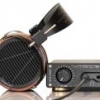-
Posts
281 -
Joined
-
Last visited
-
Days Won
3
Content Type
Profiles
Forums
Events
Posts posted by trancenonZENsedance
-
-
That is In Ears, earbuds are not tath bad for the ears.
This is true, because In-Ears block air circulation between the ear canal and outside and bacteria starts to build up inside the ear.
I've read that in-ears are better for one's hearing than old-style earphones, because they isolate better and therefore people use them at lower volume.
This will be true in most cases. You don't need to turn the music as loud to not have noise from outside disturb your listening because of the isolation. But for people who like to listen really loud anyway it doesn't make much of a difference. The music will be so loud that they don't hear any outside noise most of the time anyway (unless their surroundings become really loud for whatever reason) regardless of how isolating the phones are.
Not very reliable I would say. It is only logical that In Ears damage the ears more than earbuds, since they isolate how you say and the sound goes directly inside your ear. They have almost no distance to the hearing organ and the bass is due to the different shape of the drivers stronger than on earphones, therefore earphones are less damaging, but at lower volumes boht types are not very damaging and at high volume both will cause damage.
Hearing damage is dependent on the sound pressure level at the eardrum. How close or far away the source of those sounds is doesn't matter if the sound pressure level at the eardrum (and therefor also the perceived loudness) is the same. The frequency of a sound also plays a role, but the same basic principles apply (perceived loudness correlates with actual SPL correlates with damage over time).
I'm not really an expert on this and would appreciate it if someone corrected me if anything I wrote is wrong, but I'm pretty sure this is how it works.
-
This is the sound, man! These are the self-dribbling basketball machine elves condensed into music! Also left you a comment at soundcloud
 (Psyankali)
(Psyankali) -
So are they getting confused or not, cause I'm a bit confused there right now...
Some are really confusing the terms, others just don't care. Deconfused?

-
I know a genre that (newer) people _inside_ the scene confuse with goa/psy trance: progressive trance.



Although that might really be more a case of "who cares?" than a real confusion.
-
UX...
only one I agree with so far. I only really liked dominion (reloaded) from the UX reloaded album for example.
-
I just read the wikipedia article on it. Some people messing with the psyche of other people for some supposed benefits. Sounds a bit dangerous, but then again, so is life itself. I'm not really interested in doing something like this.
-
I raise with mine.

-
I only really know two of their albums but from those I love "The Pure" and "We Like Fluffy Music" has a great vibe.
Listening to Jajo right now. Great track!
-
From my experience I'd say it's near pointless to look for dates online. Just go to a random party and you'll have a more valuable picture of the people there within a few minutes than searching for profiles online by some criterias and reading profiles for a few hours. Reading some stats online, even if there's some personal text, cannot be compared to having someone live infront of you when it comes to determining any kind of social compatibility. Chatting people up online, just to see if there are some general shared interest and maybe eventually meet and become friends/whatever is a different story, but for pure dating purposes I really can't recommend the internet.
Might check out badoo eventually since I don't want to use facebook, maybe it's a good alternative after all.
-
My first contact with "604" was this site, probably about 14 years ago:
http://fusionanomaly.net/604.html
He stopped updating the nodes a long time ago, but now has some kind of blog, which is interesting at times. I had forgotten about it, but maybe I'll follow it again now. =)
-
-
BUMP for everyone who hasn't seen this thread, yet.
-
-
I bought a pair of these, two weeks ago: Eve Audio SC205

damn, do they sound fine.
-
I like it a lot overall, but track 6, Wintermute, is just stunningly beautiful.
-
-
But those meters are analog, and are calibrated to the analog part of the mixer, which uses the common dBu reference, which is analog and thus has no absolute maximum. Since the mixer is calibrated such that +12dBu=0dBFS, that means an analog signal which is 0dBu (like you're seeing on the mixer's meters) is equal to
(+12-12)dBu = (0-12)dBFS
0dBu = -12dBFS
like you're seeing on the DAW's meters.Ok, I get it. I'd have preferred the meters to be calibrated for digital recording, but apparently A&H saw their main purpose in monitoring the analog output.
So then, I think, there's only this question left for me: When I burn a wav-file as an audio CD, and record it from the CDj-400, through the Xone:DB2, to the PC per Audacity (all digitally connected) and then normalize to -0,01dBu, why does the result only have -13,8dBu average RMS, when the original wav-file had -9,6dBu average RMS?
-
As said before, a dB is always relative to something, so there's no such thing as 'a dB meter'. dBFS =/= dB SPL =/= Vu =/= ... There's nothing wrong with your mixer, it just has different meters than your DAW.
Yes and it does make sense to me that a digital signal is measured in -ndB to 0dB, witt 0dB being the loudest possible sound, like in Audacity. But it still doesn't make sense to me that a digital dj-mixer uses -12 dB as a reference instead of 0 dB for its meters.
-
So I guess there is something abnormal. Since the track has hardly any breaks, let alone long ones, shouldn't the average dB be much closer to 0dB than -13,8dB after normalizing to -0.01dB?
I just tried something: Contrast analysis of the left channel of the original track (Leftism - Mind Doctor) returned -9.6 dB. It's not much of a difference, but why is there any significant difference at all?
-
The above picture is a sample of a track with very little dynamic left, and is probably very loud, with estimate of about -7db average rms.
But right now I don't really care about average rms, since I'm assuming that as long as I get the peaks of the individual tracks close to 0db, the average rms would just depend on the average rms of the individual tracks. I want the peaks to be close to 0db, that is all.
so I hope you know realise what I meant when I said I was confused by your screenshot.
I'm not sure but I guess it's that the y-axis in Audacity is labelled differently than you're used to?
also, -13,8db rms seems a little bit too low imho. If played on a radio it will be very noticably lower in volume comparably

So I guess there is something abnormal. Since the track has hardly any breaks, let alone long ones, shouldn't the average dB be much closer to 0dB than -13,8dB after normalizing to -0.01dB?
-
It is most likely your mixer then. The 0 on your mixer is probably more like -12 then. In any case just peak normalize and be happy
OP,
I am happy, but this doesn't keep me from wondering why the mixer was designed this way.
-
Oh, you're recording digitally into the computer? Sorry, I guess I completely overlooked that part.
You say the signal is 'about' -12dB. Meaning the average value is about -12dB, but it goes up and down around that point?
No, I want to say that when the mixer displays 0dB on the meters (both, channel and master/mix meter always display the same level when the channel fader is in top position) Audacity records a signal at -12dB and this is what I'm trying to make sense of.
-
Your mixer is designed so that 12dBu (which is about 3.08V RMS) is the amplitude of analog voltage that will result from a sample that is all 1's: which is called 0dBFS.
But where does this come into play when my signal path for recording is entirely digital?
-
Also, on page 37 of the mixer's manual where it says "Digital Architecture Specification", it states "Analogue/Digital Line-up: +12dBu=0dBFS". Don't worry, your equipment is all fine and working according to spec.
I still don't really understand this ("+12dBu=0dBFS"), but since the manual says it's supposed to be like that and normalizing apparently isn't an issue at all, things are fine for me right now the way they are. Maybe I'll dive deeper into decibels and digital signals at some point and be able to make sense of it, but right now I want to record some mixes, since Audacity just started recording again, much in the same way it did last time when it just wouldn't start recording.

Thank you, guys, for all the valuable input, it was of great help to me!
aliendna99: The screenshot is Audacity displaying the audio in waveform (the same way a sinus wave is usually depicted going from left to right along and up and down through a straight horizontal line). If you'd still like to see a zoomed in screenshot of the waveform, let me know and how much you'd like it to be zoomed in.





The Entertaining Thread
in Off Topic
Posted
http://www.youtube.com/watch?v=LFybwg4wadI
http://www.youtube.com/watch?v=yeaTAWVcKFc